Are massage guns effective- debunking the myth
Massage guns are heavily marketed as a substitute for professional therapists, providing benefits such as sports recovery and pain... Read Article
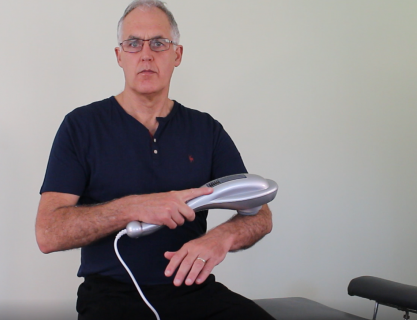
Trigger points can be a painful and sometimes debilitating condition that often require courses of therapy that can be painful, invasive (eg.needles) and expensive. Worse still, you can have all that therapy, feel better, but then the pain usually eventually returns.
The good news is that there are home therapies that are easy to do and as effective (if not more so) than those professional therapies. They will will obviously save you a lot of time and money, but the best thing is that once the pain has gone you can easily continue these home therapies on a maintenance basis, so you possibly never have to worry about trigger point pain again.
In this article we will try and give you everything you need to do this, starting from how you know if you have trigger points through to how to find and treat them.
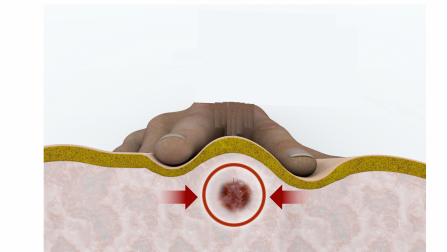
Trigger points are those tender lumps in your muscles that therapists find. They are arguably the biggest cause of musculoskeletal pain syndromes such as back neck and shoulder pain (1,2). For more details please see our article Trigger Point Basics, but in summary.
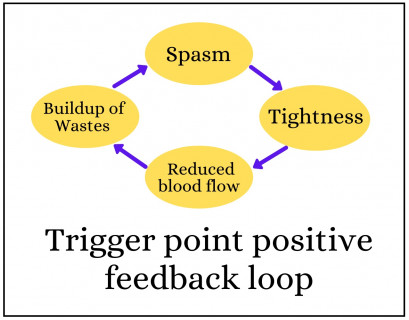
Let’s have a look at what those lumps are. This helps us understand why pain typically comes back after treatment, and how to deal with them properly. As this diagram shows those lumps in your muscles are actually a combination of muscle spasm, muscle tightness, reduced blood flow and a build up of waste products, all locked in what is called a positive feedback loop. This is like what happens when you put a microphone in front of a loud speaker and get a huge squeal until you switch it off. In the case of trigger points:
This cycle keeps going around and around in circles, with the trigger points gradually growing.
You may read about “active” and “latent” trigger points. This makes it seem that there are two different types. This is misleading because they are the same trigger points. It is just a description of whether they are aggravated and shooting pain (active) or settled and not shooting pain (latent).
It is quite common for trigger point pain to be brought on by activity then settle when resting. The trigger points are just swapping from being latent to active then back again. As we will see later most courses of trigger point therapy merely cause trigger points to go from active to latent, but of course still being there they can easily change back to active and cause pain again.
There are three main causes of trigger points:
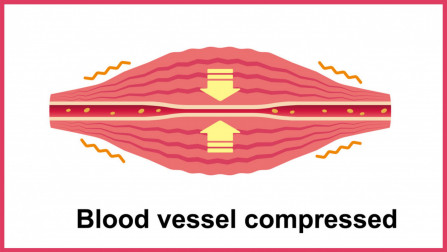
Of these probably the most insidious and important cause of trigger points is reduced blood supply due to muscle tightness. As this diagram shows tight muscles press on blood vessels, and this in turn reduces blood flow so your muscles suffer a build up of wastes, and a lack of nutrients and oxygen. Common causes of muscle tightness are:
The symptoms of trigger points are:
Studies have shown that trigger points are extremely common whether you have pain or not. As an example a study of workers with neck and shoulder pain found that they had on average 16-17 trigger points in their neck and shoulder muscles (3). If you have no pain a study of adults with no pain found that nearly 90% had trigger points in their shoulder muscles alone (4)
Trigger points do not show up in medical laboratory tests or imaging do they are diagnosed by examining the muscle looking for the following signs.
We demonstrate this in our video on forearm muscles
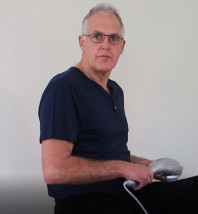
We will certainly show you some effective trigger point therapies you can easily do yourself, but we want you to have a strategy to help you be completely rid of trigger point pain forever. To do that we need to show you why pain keeps coming back after courses of therapy, then give you a proper plan to overcome this and get far better results.
The main reason pain keeps coming back after courses of trigger point therapy is that most courses of therapies are just designed to make people feel better rather than to eliminate the trigger points. This sounds completely ridiculous, but according to a scientific review of trigger point therapies the goal of these is to just deactivate the trigger points (5), which as we have seen above just changes the trigger points from hurting to not hurting. Of course they are still there and eventually become active again.
One scientific study that did try and eliminate trigger points (6) found that typical courses of therapy will have little effect on your long term number of trigger points, but if the therapies are continued for a lot longer they will be gradually eliminated. Therefore the basis of our effective trigger point treatment strategy is to give you a very effective home therapy you can keep doing for long enough to rid them. The things you need for this strategy are:
You can do a lot of therapy yourself, but to help you get the best possible results and to stay safe we recommend that you get some professional advice.
You may need to at least temporarily avoid activities that aggravate the condition
You will need a therapy that can be continually repeated long after your trigger point pain goes, then ideally done on a maintenance basis after your trigger points are gone. This can be done either wholly or partly using professional therapies. We’ve put a summary of these in an appendix, however because of time and cost most people will need at least some home therapy so we have several excellent alternatives in the next section.
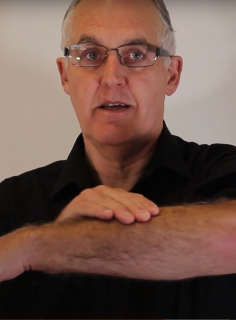
Trigger points are found by examining your muscles looking for tightness, the tender lumps that shoot pain when you press on them, and sometimes the muscle will twitch. We have the examination technique below and demonstrated in our video on treating forearm muscles. We also thoroughly recommend that when you consult a professional who deals with trigger points, ask him or her to help show you how to find them.
Gently press on the muscle with flat fingers, examining for areas of general tightness and tenderness. When found, use one or two fingers to explore more deeply for tightness and a tender lump.
There are two basic self massage techniques: i) those that mimic manual (conventional) massage and ii) vibration massage.
These are the common techniques where a therapist will hold pressure while moving along the muscle. Their technical name for this is effleurage. We liken this to squeezing out an old sponge. As shown in our video on forearm muscles to do this you lubricate the skin then use slow squeezing massage strokes along the muscle, moving in the direction towards your heart. This therapy is easy and very effective, but for self massage you are limited to where you can easily reach.
As we’ll discuss next, massage therapists often use pressure techniques to treat trigger points. You can very easily modify the basic massage techniques to include pressure. As you move your contact along the muscle, if you come to a tender lump (a trigger point) stop and maintain the pressure for 5-10 seconds before slowly moving on. Do not increase the pressure. Just use the same pressure as the massage.
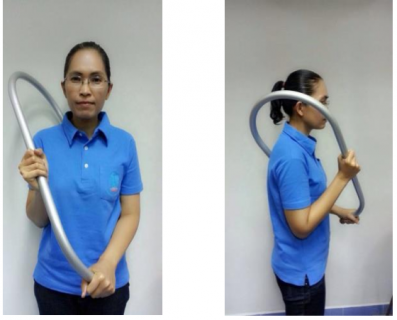
The pressure techniques used by professional therapists can be very very painful, and if you try these yourself not knowing exactly what you are doing you’ll likely hurt yourself. However, scientists have found a simple technique where you can use only moderate pressure and still get great results. In a trial of a traditional Thai home massage (9) a special tool with a long handle was used to apply moderate pressure. Each day each trigger point was given five applications of five seconds pressure each. This pic shows the tool used in the trial, but there are many similar ones on the market.
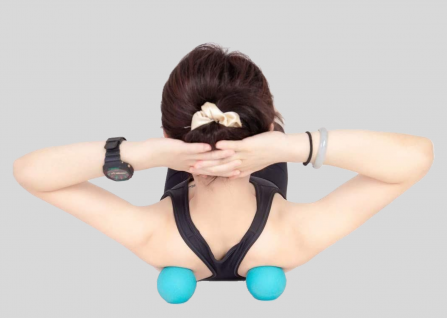
The use of balls and foam rollers is widely recommended. However, as discussed in our article on foam rollers we do not recommend these. The results of clinical trials of these have been poor and we have serious reservations about their safety. This picture illustrates some of our concerns. The lady using the Thai technique does not need to get into any awkward positions. The muscles she is treating are relaxed, and she can easily control the pressure.
On the other hand the person using the foam roller is in an awkward position. Her muscles are far from relaxed, and it would be far harder to control the pressure.
The manual techniques we’ve shown you are perfectly good and give you options needing either no equipment or a simple tool. However, vibration massage is by far the easiest and most effective option if you have the correct equipment. Vibration massage is:
Vibration massage requires no special massage skills. Basically all you need to do is sit the head of the vibration massager over the trigger point and allow the vibration to penetrate.
With vibration massage it is the vibrations that penetrate. There are no needles or painful pressure. You usually just feel the pleasant sensation of the muscle gradually relaxing.
As discussed in our article What is the best treatment for trigger points vibration massage is probably the most complete of all therapies. Further, self vibration massage can be equally as effective as that provided by a professional. As long as you place the massager in the correct spot it doesn’t matter who is holding the handle.
With vibration massage is it just the vibrations that penetrate. Because there is no pressure or penetration with needles it is very safe.
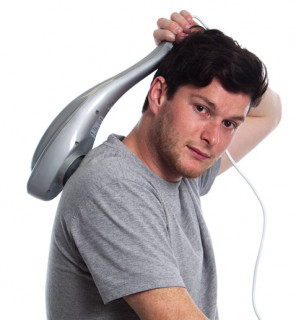
Using vibration massage is extra-ordinarily easy. We ask you to check our our instructions for the fine points and precautions, but basically all you need to do is place the vibration massager on the muscle over the trigger point and let the vibrations penetrate for 30-60 seconds. This can easily be repeated every day. Please note that you need a proper effective vibration massager. As discussed in our article How to choose a massager most of the common massage guns and percussion massagers will not be effective and many are potentially dangerous.
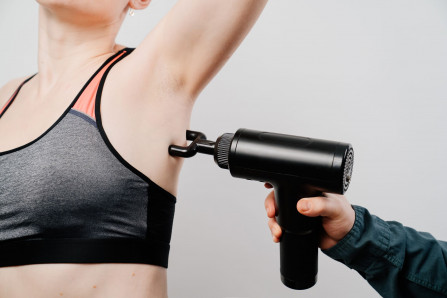
Massage guns and percussion massagers are widely marketed for treating musculoskeletal pain. However, as discussed in our article Are massage guns a gimmick these are far less effective than genuine vibration massager massagers and carry serious safety risks. You are far better off getting a genuine vibration massager such as our General Purpose Massager or our Ultimate Quad Head Massager.
At the start it is very easy to monitor your improvements: your trigger points will hurt less. However, once the trigger points are no longer active (hurt) we recommend the following checking routine.
Examine for your trigger point. You will need to do this to find the trigger point to treat anyway.
Re-examine your trigger point after treatment to make sure the lump is smaller and less tender.
There is always the option to have some or all of your therapy done by professionals so we’ve done a summary of what several scientific reviews of trigger point therapies have said about each of the common ones (5,7,10–14). Keep in mind though that most of the clinical trials that these scientists have reviewed just tested whether their therapies converted the trigger points from active (shooting pain) to latent (not shooting pain). Therefore we get an idea of the relative merits of each, but they don’t really say anything about eliminating your problem.
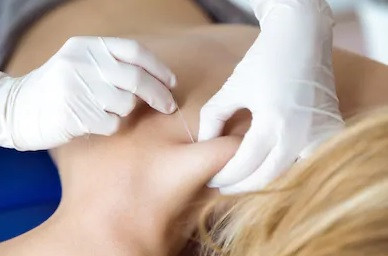
Most trials show that dry needling provides some short term pain relief and improved function. The risks and potential to cause pain are obvious. The mode of how needles work is still speculation. Where dry needling had been compared with laser the laser has given slightly better results.
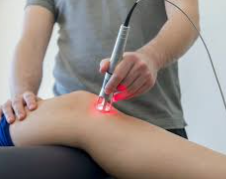
Trial results for laser have been marginally better than those for dry needling, but still only temporary relief. Scientists attribute it’s effect to increasing micro-circulation, improving oxygenation and helping remove waste products. However, this is something that can easily be achieved, if not better, by any competent massage therapist.
The big concern with laser is the sheer number of applications of therapy sessions needed for only temporary benefits. For example one trial (12) used 10 daily applications of laser on patients with upper back and neck pain to get a reduction in pain and tenderness for three weeks. Further, according to one review (13) applications of laser should be given from 2-3 times a week though to 5 times a week, with a total of 30 applications of therapy for long term cases. Keep in mind this is just to achieve deactivation, not to eliminate the problem. Assuming each laser consultation costs $50 and takes an hour out of your day that’s $1,500 and 30 hours of your life just for some temporary pain relief, leaving you to front up again next time the problem is aggravated.

There are various types of manual therapies that involve pressure, massage and stretching of muscles. The trial results for them tend to be similar to those of laser and dry needling. However, according to one review (6) one study did show residual benefit after six months.

If you are a professional wishing to help your patients/clients with home trigger poing therapy DrGraeme massagers were originally built by Dr Graeme for use in his clinic for this purpose and are now used by colleagues and other professionals for similar purposes. If you are a professional and wish to know more about this therapy, or possibly get a sample massager to trial please check out our practitioner page.
We are continually adding more information on research and uses. Subscribe below to have us email them to you "hot off the press".

Several years ago Dr Graeme, a Chiropractor practicing in Victoria, Australia was looking for a serious hand held massager his patients could use at home to get the extra quality massage they needed. The ones he found in the shops and on-line for home use looked nice but were not serious, and... read more
Massage guns are heavily marketed as a substitute for professional therapists, providing benefits such as sports recovery and pain... Read Article
Clinical trials have shown that massage is effective in relieving fibromyalgia. However, the results show that some are better than... Read Article
DOMS (Delayed onset muscle soreness) is soreness normally felt in muscles for a few days after strenuous exercise. According to... Read Article
Two of the best studies of shoulder pain found that (myofascial) trigger points in 17 different muscles contribute to shoulder pain... Read Article
Scientists have found that a high proportion of headaches result from pain coming from the muscles and joints of your head and neck. ... Read Article
Trigger points can be a painful and sometimes debilitating condition that often require courses of therapy that can be painful, invasive... Read Article
To become fitter, stronger and faster your need to push your body to create the microscopic damage that stimulates improvement. That... Read Article
(Myofascial) trigger points are a large but often overlooked cause of tennis elbow, with this omission being responsible for too many... Read Article
Do not refresh or leave this page until loading complete.